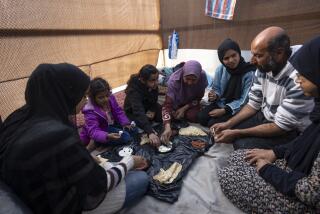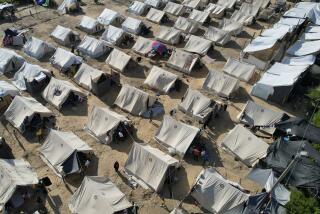Mass Migration Turns Cairo Into Urban Dungeon
- Share via
CAIRO — Mass migration from the countryside and an out-of-control birthrate have transformed Cairo from a genteel garden city into an urban dungeon of jammed streets, deadly air and buildings literally crumbling under the weight of their inhabitants.
In only 30 years, Cairo’s metropolitan population has swelled from 2.5 million to an estimated 12 million. Tens of thousands more stream in every year in search of work.
If the growth rate continues unchecked, some experts fear that Cairo, already the largest city in Africa and the Middle East, will mushroom to more than 20 million by the end of the century.
‘It Will Be a Disaster’
“We can solve our housing problems,” says Milaad Hanna, chairman of the Parliament’s housing committee. “But if the city grows to 20 million, it will be a disaster.”
Poor Come to City
The rural poor come to the city to escape the poverty, drudgery and boredom of country life, which in some cases has changed little in 5,000 years.
But they come to a city that, unlike others in the Third World, cannot absorb newcomers in sprawling shantytowns on its fringes. Pinched on three sides by stark, rocky desert, squeezed into a Nile River valley less than three miles wide, Cairo’s millions crowd an area adequate for less than a quarter of their numbers.
Amid the filth of neighborhoods that are often without water or electricity, hundreds of thousands are packed as many as 10 to a single room, or under rooftop shelters on buildings thrown up with little regard for safety codes.
About 100,000 people have found shelter in medieval tombs in the City of the Dead, rearing their families beside the graves of Mameluk-era rulers. Forty thousand others live in huts atop the city garbage dump.
Population Density
City officials estimate that in some districts population density is as high as 300,000 per square mile, four times that of Manhattan.
The mass migration from the countryside has fundamentally altered the character and flavor of Cairo, long considered the Arab world’s most sophisticated center.
Handsome Nile-side homes and spacious gardens have been torn up to make way for high-rises. Most of the old sidewalk cafes have vanished from the heart of the city. Pedestrians now elbow and jostle past each other or squeeze through thousands of parked cars that block side streets and alleys. About 80,000 donkey carts compete with cars, trucks and buses.
‘Ruralizing the City’
“They are ruralizing the city,” sociologist Nazek Nasir says of the newly arrived peasants.
Migrants Dump Garbage
The migrants still wear traditional galabiya robes, instead of the Cairenes’ usual Western attire. They dump garbage in front of their homes and walk down the middle of the street, as though they were back in their villages.
“Their way of life does not change drastically by coming to the city,” Nasir says. “Living conditions are not any better than they left at home, and sanitation conditions are equal if not worse than they left behind, because at least they had fresh air and greenery around them.”
The 1967 Middle East War accelerated the country-to-city migration, driving hundreds of thousands from battle zones near the Suez Canal. “Metropolitan areas are very attractive to migrants from rural areas who are unemployed or underemployed,” she says.
Thousands of young men remain in Cairo after completing mandatory military service so they can use their new electrical, carpentry or other skills more lucratively than at home.
‘Make Much More Money’
One middle-age woman, Umm Mohammed, who lives with her husband and four children in one room in the Sayeda Zeinab district, explains how she came to the city: “When I was about 14, my uncle, who lived in Cairo, came and took me to work as a maid for some people he knew. I wanted to come to the big city, and I make much more money than I could in the country.”
The Egyptian government, keenly aware of the crisis facing its capital, has been spending almost $2.5 billion annually in a desperate effort to improve housing, transportation, communications and water supply.
But solutions often create problems of their own.
For example, Youssef Sabry Abu Taleb, Cairo district governor, estimates that the city needs to build 40,000 to 50,000 new apartments every year to keep pace with demand. But most of the construction has been on farmland, about 100,000 acres of which is lost every year to new housing around Cairo and other cities.
Shrinking Farmland
In a nation that is mostly desert, population growth combined with shrinking farmland means that a people once self-sufficient agriculturally now import about half their food.
Another case: Work is under way on a subway to improve Cairo’s transportation system. But the first segment is not scheduled for completion until 1987, and the construction sites have further snarled an already chaotic traffic situation--tie-ups that contribute to making Cairo’s carbon monoxide levels four times higher than the standard U.S. “danger” level.
Hanna says current improvements in telephone, electricity and other services actually will be harmful in the long run by encouraging people to remain here.
“The government knows if they don’t do something about the situation in Cairo, they may have political trouble,” he said in an interview. “But I believe it was a mistake to make Cairo more livable.”
The government also has been building nine new towns in the desert near Cairo and Alexandria to drain off population, but the planned communities are not attracting the numbers authorities hoped they would.
Some Western diplomats and aid experts, who asked not to be identified, said they believe all efforts to improve Cairo life will fail until Egypt controls its population growth rate, which at 2.7% a year is one of the world’s highest.
“If present rates continue, the population will double in 30 years and a lot of them will wind up here,” one diplomat says. “I just don’t know where they will put them all.”
More to Read
Sign up for Essential California
The most important California stories and recommendations in your inbox every morning.
You may occasionally receive promotional content from the Los Angeles Times.










